Pumpkins are one of the most versatile and beloved crops in the world; they can be used for everything from delicious pies and soups to festive decorations and even competitive events.
But, do you even know how much does an average pumpkin weigh?
The research says that on average, a medium-sized pumpkin weighs between 10-20 pounds (4.5-9 kg). However, it can mostly vary depending on the variety, growing conditions, and several other factors.
In this article, we will explore the factors that affect pumpkin weight, how much an average pumpkin weighs, pro tips for selecting the perfect pumpkin, and special tips for growing big pumpkins.
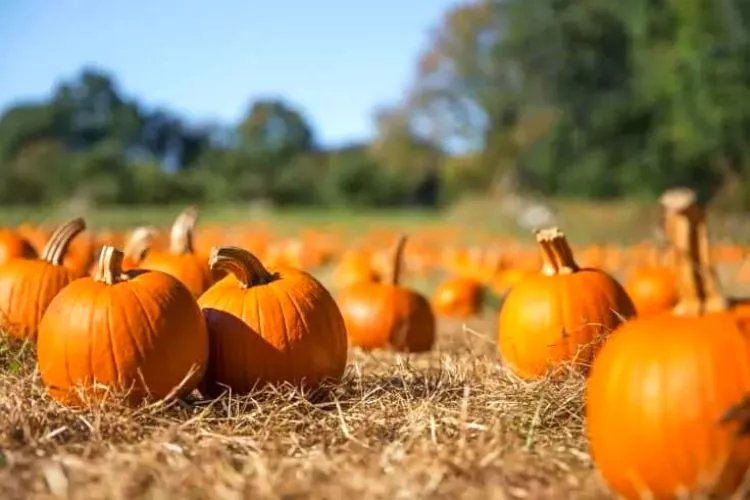
Whether you’re a farmer, a chef, or simply a lover of all things pumpkin, this article has something for everyone. Let’s dive in and learn about the fascinating world of pumpkin weight and selection!
Table of Contents
Factors affecting pumpkin weight
When it comes to growing pumpkins, the weight of the fruit is an important consideration for farmers, gardeners, and pumpkin enthusiasts alike. Achieving optimal pumpkin weight can be influenced by a wide range of factors.
These include the type and variety of pumpkins being grown, the growing conditions, cultivation techniques, and even harvest timing.
In this section, we’ll explore these factors in detail to provide a comprehensive understanding of what it takes to grow optimally sized, healthy pumpkins.
Types of Pumpkin (Edible and Ornamental)
There are many different types of pumpkins, and they can be split into two broad categories, edible or ornamental. Edible pumpkins, as the name suggests, are grown for culinary purposes, while ornamental pumpkins are grown for decoration.
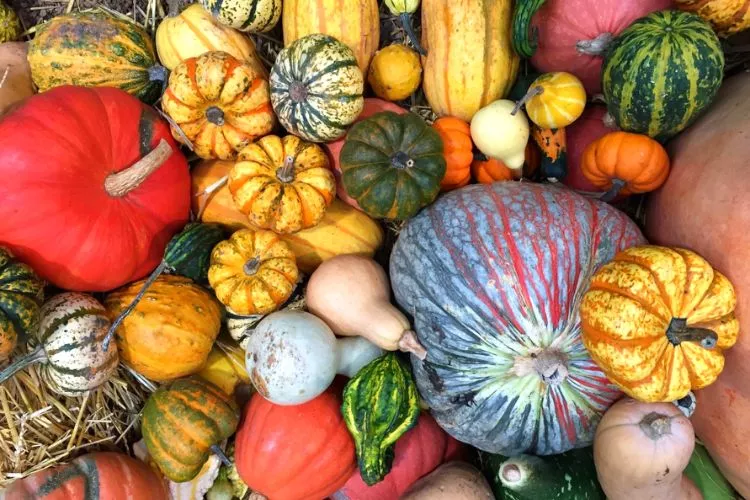
The weight of edible and ornamental pumpkins can vary significantly. For example, ornamental pumpkins are often larger because they are used as showpieces in competitive events like pumpkin weighing contests.
On the other hand, those used in cooking don’t need to be as big but need to have great taste.
Varieties of Pumpkins and Their Average Weight Range
The weight of a pumpkin can also vary depending on the variety. For example, smaller varieties like Sugar Pie, Cinderella, and Lumina pumpkins typically weigh 5-10 pounds, while larger varieties such as the Atlantic Giant and Big Max can weigh over 1,000 pounds.
It’s important to research the average weight range of different pumpkin varieties before planting to ensure that the desired size can be achieved. Don’t forget that you may also need to prepare a garden bed or containers according to these sizes.
Growing Conditions and Climate
The environment in which pumpkins are grown can also significantly impact their weight. Pumpkins prefer warmer temperatures and plenty of sunlight to thrive. They also require adequate water and humidity, but not too much or too little, as this can lead to problems like rot or mildew.
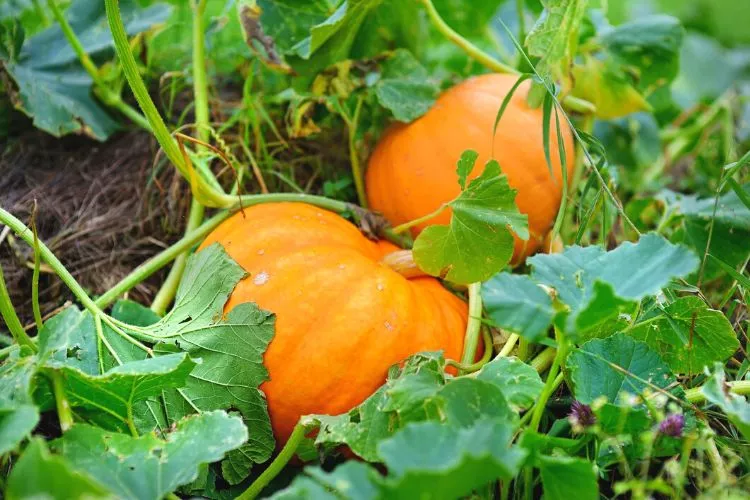
Extreme weather conditions like drought or excessive rainfall can also impact pumpkin growth and weight. These issues can be somewhat mitigated by planting them in a greenhouse that provides optimal conditions.
Cultivation Techniques
Variations in growth techniques and methods are also known to impact the size and weight of a pumpkin. Choosing a site with well-draining soil and plenty of space for the vines to spread out is important.
Pumpkin plants should be watered regularly, not too much, and fertilized with a balanced fertilizer. Pruning and training the vines can also help encourage larger fruit growth.
Their growth can be severely hampered when they become confined and restricted in movement.
Soil Fertility and Nutrients
Another important factor for achieving optimal pumpkin growth is the quality and nutrient content of the soil. Pumpkins thrive best in soil rich in organic matter and nutrients such as nitrogen, phosphorus, and potassium.
Soil pH should be in the range of around 6.0-6.5 for best results.
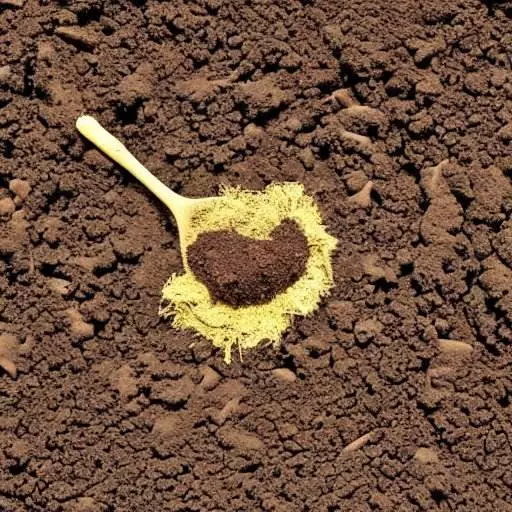
The best way to determine if any amendments should be made to the soil is by taking a simple soil test and correcting it accordingly. You can use lime to increase the pH of the soil (reducing the acidity) or sulfur to decrease the pH of the soil (to help acidify).
Pests and Diseases
A small handful of pests and diseases can impact your pumpkins’ growth and weight. Some of the most common pests include squash bugs, cucumber beetles, and aphids, while diseases like powdery mildew and vine borers can also affect pumpkin plants.
Treating and preventing pest and disease issues is essential for ensuring that pumpkins reach their full weight potential.
Maturity and Harvesting Time
The time at which pumpkins are harvested can also impact their weight. Therefore, waiting until pumpkins are fully mature and have achieved their maximum weight before harvesting is important.
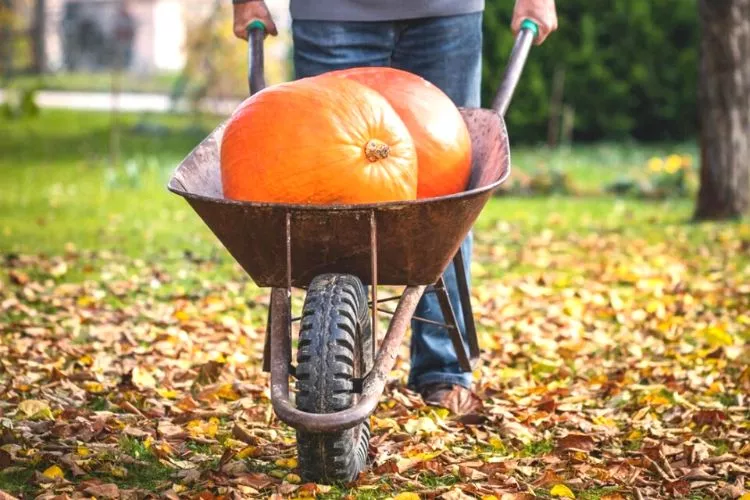
Harvesting them too early can result in an underdeveloped fruit, while harvesting too late can lead to overripe, rotting pumpkins that are prone to insect damage and disease.
We recommend marking down on a calendar when they were planted and using that as a rough guide when it comes to harvesting.
Additional Factors Affecting Pumpkin Weight
Other factors that can impact the weight of a mature pumpkin include genetics, pollination, and even plant spacing.
- Certain pumpkin varieties are bred specifically for their size, and these genetics can play a role in achieving large pumpkins.
- Adequate pollination, which can be facilitated by attracting pollinators, is also important for achieving optimal pumpkin weight.
- Finally, giving pumpkin vines enough space to grow and spread out is crucial for ensuring they have enough resources for fruit development.
How Much Does an Average Pumpkin Weigh?
The weight of a pumpkin can vary greatly depending on the variety, growing conditions, and other factors. However, on average, a medium-sized pumpkin weighs between 10-20 pounds (4.5-9 kg).
Here is a round up of some common edible and ornamental pumpkin varieties:
Edible Pumpkins
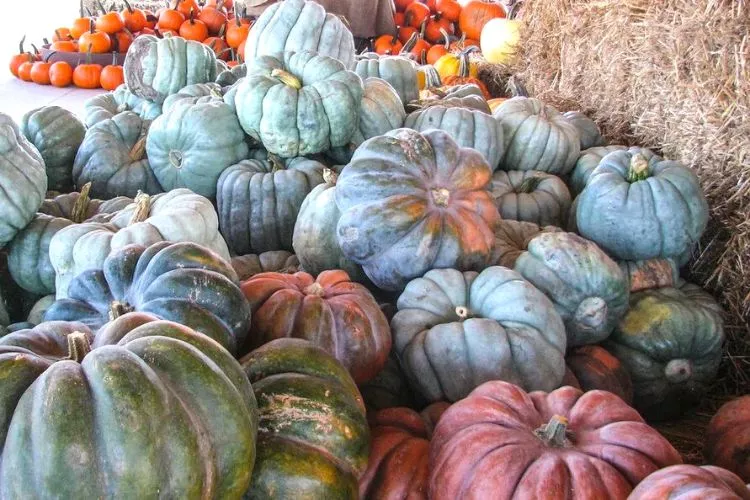
- Sugar Pie: These pumpkins are small and round, typically measuring 6-8 inches (15-20 cm) in diameter. They have a bright orange color and a sweet, smooth flesh that is perfect for baking.
- Cinderella: Also known as Rouge vif d’Etampes, these pumpkins are named after the fairy tale character due to their flattened, ribbed shape and distinctive deep red-orange color. They typically measure around 10-20 inches (25-50 cm) in diameter and have a sweet, nutty flavor.
- Jarrahdale: These pumpkins have a unique blue-gray color and a flattened shape with deep ribbing. They typically measure around 10-12 inches (25-30 cm) in diameter and have a sweet, nutty flavor.
- Lumina: These pumpkins are small and round, measuring 6-8 inches (15-20 cm) in diameter. They have smooth, bright white skin that is perfect for decorative purposes and sweet, tender flesh that is great for baking.
Ornamental Pumpkins
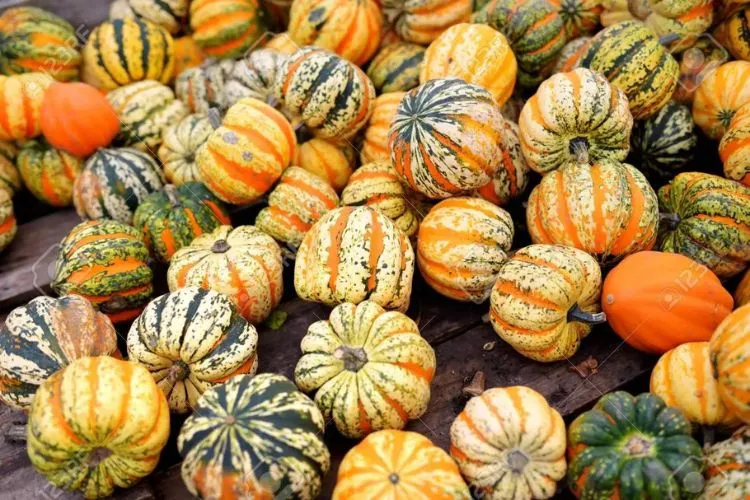
- Jack-o’-lantern: These pumpkins are the classic choice for carving into Halloween decorations, with their round shape and bright orange color. They typically measure around 10-25 inches (25-64 cm) in diameter and have a mild, slightly watery flavor.
- Howden: These pumpkins are large and round, typically measuring around 20-35 inches (50-90 cm) in diameter. They have a bright orange color and thick, tough skin, making them great for carving and displaying.
- Big Max: As their name suggests, these pumpkins can grow very large – up to 100 pounds (45 kg) or more! They have a round, flattened shape and bright orange color, with a sweet, tender flesh that is good for baking.
- Atlantic Giant: These pumpkins are bred specifically for size and can grow to be enormous – over 1,000 pounds (450 kg) sometimes! They have a round shape and a bright orange color, with sweet, watery flesh that is not ideal for eating but is great for carving and display purposes.
Edible pumpkins are typically smaller and sweeter than ornamental pumpkins. At the same time, ornamental pumpkins are often larger and better for carving or display purposes.
Choosing the right variety of pumpkins for your intended use is important.
Additionally, the size and weight of pumpkins can vary even within the same variety, so it’s important to pay attention to individual pumpkins rather than just relying on averages.
Here is a quick comparison table of the same common pumpkin varieties and their average weights:
Sugar Pie:
- 6-8 inches / 15-20 cm
- Sweet, smooth
- Small, round, bright orange
- Edible
Cinderella:
- 10-20 inches / 25-50 cm
- Sweet, nutty
- Flattened, ribbed, deep red-orange color
- Edible
Jarrahdale:
- 10-12 inches / 25-30 cm
- Sweet, nutty
- Unique blue-gray color, flattened shape, deep ribbing
- Edible
Lumina:
- 6-8 inches / 15-20 cm
- Sweet, tender
- Small, round, smooth, bright white skin
- Edible
Jack-o’-lantern:
- 10-25 inches / 25-64 cm
- Mild, slightly watery
- Round, bright orange, classic choice for carving
- Ornamental
Howden:
- 20-35 inches / 50-90 cm
- Thick, tough
- Large, round, bright orange, thick skin
- Ornamental
Big Max:
- Up to 100 pounds / 45 kg
- Sweet, tender
- Round, flattened shape, bright orange
- Ornamental
Atlantic Giant:
- Over 1,000 pounds / 450 kg
- Sweet, watery
- Round, bright orange, bred for size
- Ornamental
Pro tips for selecting the perfect pumpkin
When selecting the perfect pumpkin for your needs, there are a few factors to consider that will help you choose the best one. Let’s have a look at some pro tips for picking out the best pumpkin for your needs:
- Choosing the right pumpkin for your purpose: Before you start shopping for it, consider what you’ll be using it for. If you’re planning to carve a jack-o’-lantern, for example, you’ll want a large, round pumpkin with a smooth surface. In this case, a Big Max may be a good choice. If you’re using the pumpkin for cooking, on the other hand, you’ll want one with sweet, flavorful flesh, such as a Sugar Pie.
- Factors to consider when buying a pumpkin: Look for a pumpkin free of blemishes, bruises, and soft spots. Check the stem to ensure it is firm and attached securely to the pumpkin. Also, ensure the pumpkin is the right size and shape for your needs. Only use what you need!
- How to tell if a pumpkin is ripe: A pumpkin should have hard, tough skin that can resist punctures and dents. The stem should be dry and firm, and the pumpkin should feel heavy for its size. To test the ripeness of a pumpkin, press your thumbnail into the skin. If the skin doesn’t give, the pumpkin is ripe.
Special Tips for Growing Big Pumpkins
If you’re looking to grow a giant pumpkin for competition or personal enjoyment, there are a few special tips you can apply to your growing tenure to help them become the pumpkins you want them to be. Here’s what you need to know:
- Selecting the right pumpkin variety: To grow a giant pumpkin, you’ll need to choose a variety bred for size, such as the Atlantic Giant or Big Max. Remember, different pumpkins are grown for different purposes. If you’re after edible pumpkins, then choose one for that purpose; the same goes for ornamental ones.
- Preparing the soil and ensuring proper drainage: Pumpkins require rich, well-draining soil high in organic matter. Before planting, make sure to amend the soil with compost or other organic matter. Ensure that the soil isn’t heavily compacted and includes some materials like gravel, sand, or perlite to help with aeration and drainage.
- Providing adequate water and nutrients: Pumpkins require a lot of water to grow and produce a good yield. Generally, they need about 1 inch (2.5 cm) of water per week, either from rainfall or irrigation. When exposed to hot and dry weather, they may need a little extra water. Watering deeply and consistently encourages healthy root growth and prevents the fruit from cracking is important.
- As for fertilization, pumpkins need many nutrients to grow big and healthy. They should be fertilized every 2-3 weeks with a balanced fertilizer high in nitrogen, phosphorus, and potassium. A 10-10-10 or 20-20-20 fertilizer can work well for pumpkins. In addition, it’s a good idea to amend the soil with compost or other organic matter before planting to improve soil fertility and structure.
- Controlling pests and diseases: Pumpkins are susceptible to a variety of pests and diseases, including powdery mildew, squash bugs, and vine borers. Watch for signs of damage and take action as soon as possible to prevent further spread. For example, you can use insecticidal soap or neem oil to control pests and remove infected plant parts to prevent the spread of disease.
- Monitoring pumpkin growth and supporting with netting or cradles: As your pumpkin grows, you may need to provide support to prevent it from breaking off the vine. Consider using netting or cradles to support the pumpkin and protect it from damage.
In addition to these tips, keeping a close eye on your pumpkin as it grows is important. Monitor its growth and take action to address any issues as soon as they arise. By following these tips, you’ll be well on your way to growing your desired-sized pumpkin that will envy all your neighbors.
Where can I see big pumpkins?
Here are some of the most popular pumpkin festivals and competitions around the world where visitors can see and admire giant pumpkins:
- Circleville Pumpkin Show, Ohio, USA
- Half Moon Bay Art & Pumpkin Festival, California, USA
- Ludwigsburg Pumpkin Festival, Germany
- Windsor Pumpkin Regatta, Nova Scotia, Canada
- The Giant Pumpkin Festival, Canberra, Australia
- Harrogate Autumn Flower Show, North Yorkshire, UK
- Sankt Andreasberg Pumpkin Festival, Germany
- Pumpkin Festival and Regatta, Missouri, USA
- Cucurbita Festival, Italy
- Damariscotta Pumpkinfest & Regatta, Maine, USA
These events may have varying dates, times, and locations. It’s best to check their websites for up-to-date information before planning a visit.
Frequently Asked Questions (FAQs)
How much does a small pumpkin weigh?
The average small pumpkin typically weighs 2-5 pounds (1-2 kg).
What is the biggest pumpkin ever recorded?
The biggest ever recorded pumpkin was grown in 2016 by Mathias Willemijns of Belgium and weighed in at a whopping 2,624 pounds (1,190 kg)
How much does a pumpkin weigh when it’s full of seeds?
A pumpkin’s weight when it’s full of seeds can vary depending on the size of the pumpkin, but it typically adds around 1-2 pounds (0.5-1 kg) to the total weight.
How much does a pumpkin weigh when it’s carved?
The weight of a carved pumpkin can vary depending on the size and thickness of the removed pumpkin walls, but it typically weighs about 1/3 to 1/2 of its original weight.
Conclusion:
In conclusion, the weight of an average pumpkin is an important consideration for many purposes, including cooking, decoration, and competitions.
By understanding the factors that affect pumpkin weight, you can select the right variety and take steps to ensure a healthy and bountiful harvest.
From the Sugar Pie pumpkin to the Atlantic Giant, there are many varieties depending on your needs. We hope this guide has helped provide insights into the world of average-sized pumpkins.
For more related topics, please visit our website, and check back soon for more informative articles.


